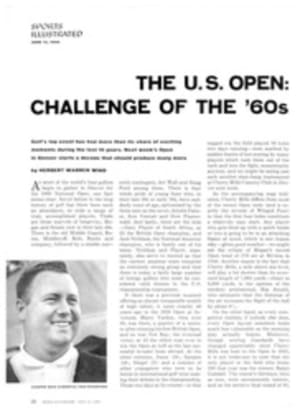
The lordly salmon
In Maine and eastern Canadaanglers already are on the streams as Salmo salar, the Atlantic salmon, begins the 1960 upriver run from the sea. From now until September fly-fishermen will be dropping Dusty Millers, Silver Doctors and Cossebooms into legendary pools of the Cascapedia and the Restigouche, the Upsalquitch, the Humber and the Margaree.
The man who can catch an Atlantic salmon and get it home to table will be doubly lucky. Salmo salar is a unique challenge in his native stream; approached with a fork he is one of the outstanding delicacies of the Western world.
But it is not necessary to journey to the northeast woods—or even to be a fisherman—to enjoy fresh Atlantic salmon. The fish is supplied to many U.S. markets by coastal fisheries.
It is generally conceded among the Atlantic-salmon-consuming nations (northern Europe as well as North America) that the fish tastes best baked, broiled or simply simmered in a court bouillon—a combination of water, white vinegar, vegetables and seasonings. To me the last-named method is the finest.
The ideal way to poach a whole salmon is in a long fish boiler, one with a cover and a rack on which to rest the fish. If you don't have a cooking vessel long enough, can't beg one from a neighbor and still want to cook your salmon whole, try borrowing from a friendly restaurant.
Garnishing the fish before serving can be an elaborate procedure, or it can be as simple as that shown at the left: the fish lies on a bed of chopped aspic—easily made from clear jellied chicken consommé—and is garnished with cooked shrimp and radishes.
Of the many classic sauces to accompany cold salmon, perhaps the very best are sauce verte (green sauce) and sauce moutarde (mustard sauce). Given here is a variant of green sauce that I once encountered in Cuba.
COLD ATLANTIC SALMON
(A 10-pound salmon weighs about 8 pounds cleaned. It easily serves twelve)
Prepare court bouillon by simmering in a fish boiler. Meanwhile, sew up the cleaned salmon in cheesecloth. Place fish on rack and lower into the hot liquid. Cover. After court bouillon comes again to a slow boil, uncover and adjust heat so the liquid just simmers. Cooking time for a salmon of this size will be a bare half hour after the court bouillon returns to the boil; for a larger or smaller fish the time will vary proportionately. Test for doneness by pressing lightly on the surface of the fish. When surface gives slightly, salmon is done. Do not overcook. Remove fish boiler from fire and allow salmon to cool completely in the liquid in which it has cooked (this may be done overnight).
After cooling, remove rack from boiler with salmon on it. Take off cheesecloth and allow the fish to drain. Remove skin in whole or in part. Place fish on a platter and decorate as desired.
Green sauce for salmon
2 bunches watercress (leaves only)
1/4 pound spinach leaves
1 pint mayonnaise
1/2 pint sour cream
Juice of 1½ to 2 limes
Salt, white pepper, cayenne, mace (a tiny pinch) and Tabasco or other hot pepper sauce—all added to taste
A few drops juice squeezed from fresh garlic, or a dash of garlic salt
A few drops green vegetable coloring
Drop watercress and spinach leaves into boiling water for a few seconds and drain quickly through a fine strainer. Squeeze out water. Then force the leaves through the strainer (or else run leaves with¼ cup of the sour cream through a blender until puréed). Add purée to mixture of mayonnaise, sour cream and lime juice. Add seasoning and green coloring. Whip well. Chill before using.
PHOTO
LOUISE DAHL-WOLFE; PLATTER FROM BONNIERS
TEN-POUND SALMON, WHICH HAS BEEN COOKED WHOLE AND CHILLED BEFORE SERVING, IS PRESENTED ON BED OF CHOPPED ASPIC TO MAKE IMPOSING SUMMER PLATTER

